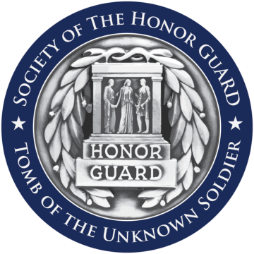Thomas Hudson Jones
11 years ago
Every soldier who has guarded the Tomb of the Unknown Soldier since the 1930s knows that Lorimer Rich and Thomas Hudson Jones were the two men chosen as the architect and the sculptor of the Tomb of the Unknown Soldier – their names appear on the first step on either side of their work, the Tomb of the Unknown Soldier. We have admired the sculpture on the Tomb during the night time. We marvel at the detail of the three figures of Victory, Peace, and Valor as we wait for them to somehow come to life.
But what do we know of the man who literally had one chance to “get it right?”
Thomas Hudson Jones was born July 24, 1892 in Buffalo, New York. His father was an engraver by trade and encouraged his son to be a sculptor. He attended the Albright Art School in Buffalo, and at 19 he won the Rome Prize Fellowship for three years of study at the American Academy in Rome. The judges, however, decided that he was too young to go at the time.
For a time Jones worked in the studio of Daniel Chester French as French worked on the sculpture of the seated Lincoln for what would become the iconic figure in the Lincoln Memorial. Jones left French in 1917 and entered the US Army where he served in World War I. Following the war he took the fellowship in Rome.
He returned to the United States in 1922 to sculpt and teach at Columbia University in New York City. In 1934 he returned to Rome to serve as a Professor of Fine Arts at the academy. Jones designed the ornate 50-foot-high bronze doors for the New Library of Brooklyn. In Washington, D.C., he designed three reliefs of law givers for the House of Representatives chamber in the United States Capitol (1950) and the Statue of Christ in St. Matthews Church in Washington, D.C.
In 1929 the Fine Arts Commission selected Jones and Lorimer Rich from among 74 sculptors and architects to design the Tomb of the Unknown Soldier. It turned out that the selection of Rich and Jones was the easy part. Delays in the selection of marble took nearly two years as the 50-ton die block was brought to Arlington…only to be rejected for a flaw. This started the process all over. In the meantime, the east side of the Memorial Amphitheater was renovated to open the view from the plaza all the way to the Potomac and Washington, DC. By December 1931 a replacement block had been delivered and work resumed. On the last day of 1931, the cap was placed over the crypt and sealed into place. It was now that Jones went to work sculpting the three central figures and the six inverted memorial wreaths – a commission he finished in a matter of weeks. On April 9, 1932 the completed monument was open to the public.
For Jones, it was this work that made him well known in government circles.
At the request of the Government, Jones left his McDougal Alley studio in Greenwich Village, New York in 1944 and started work for the Institute of Heraldry in Washington, DC where he stayed after the war ended. It was here that Jones went on to design well over 40 US military service medals including the World War II Victory Medal, Airman’s Medal, Women’s Army Corps Service Medal, Army of Occupation Medal, and the National Defense Service Medal.
Other works of note are the ornate 50-foot-high bronze doors for the New Library of Brooklyn. In Washington, D.C., he designed three reliefs of law givers for the House of Representatives chamber in the United States Capitol (1950) and the Statue of Christ in St. Matthews Church in Washington, D.C.
Thomas Hudson Jones died on November 4, 1969 in Hyannis, Massachusetts. By many accounts, the place of his burial is unknown; for the Tomb Guards, he will never be forgotten.
Kevin Welker
Sources:
Poole, Robert M. On Hallowed Ground: The Story of Arlington National Cemetery. New York: Walker and Company, 2009.
United States Army Insignia Home Page
http://usarmyinsigniahomepage.netii.net/armyhome.html
Thomas Hudson Jones -- http://en.wikipedia.org/wiki/Thomas_Hudson_Jones
Latest News
Dave Rappaport Speech from Reunion 2023
Posted November 6, 2023 in Special ReportSpeech presented to the 2023 Gathering of Tomb Guards Banquet for the Society of the Honor Guard, Tomb of the Unknown Soldier on November 4, 2023. Dear Honored dinner guests, It is indeed an honor...
Winter Rose Protection for Niphetos in your Never Forget Garden
Posted October 2, 2023 in Centennial{!{rs}!}**Article republished from the White Rose Journal: The Never Forget Garden Project. To find out more visit HERE** Follow these 10 tips, so your winter tender Niphetos will thrive every...
9/11 Ceremony - Paris 16EME
Posted September 27, 2023The History of the Tomb of the Unknown Soldier in 26 paintings by artist Dave Rappaport going on exhibit in France (three locations). Presented by the Military Women's Memorial and the Society of...
Support the Society
The Society of the Honor Guard, Tomb of the Unknown Soldier (SHGTUS) is able to provide our programs, events, assistance, scholarships, and services due to the generosity of its members, organizations, and individuals. SHGTUS does not receive institutional funding. Note: The Society of the Honor Guard, Tomb of the Unknown Soldier is a 501(c)(3) organization, so your contributions may be fully tax deductible.
Learn More
Did you know?
Is the rifle that the Sentinel carries loaded?
Tomb Guards carry fully functional M14 rifles. Given the current climate surrounding the relatively recent tragic events in Canada (attack upon the guard at the Canadian War Memorial), we will no longer be answering questions relating to specifics regarding current security and armament at the Tomb of the Unknown Soldier. We appreciate your understanding.
Rest assured, that the US Army has the post secured as it has been since we started guard duty at the shrine in 1926.



